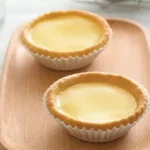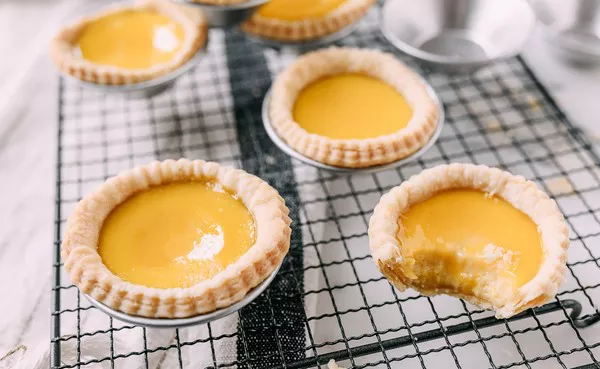Hong Kong-style egg tarts are iconic pastries that have won the hearts and palates of food lovers around the world. These delightful treats consist of a flaky, buttery pastry shell filled with a velvety, sweet custard that’s often characterized by its glossy surface and perfectly balanced flavor. Whether you’ve enjoyed them on the bustling streets of Hong Kong or at your favorite local bakery, learning to make these delectable egg tarts at home is a rewarding culinary adventure. In this comprehensive guide, we’ll take you through every step of the process, from crafting the pastry shell to achieving the perfect custard filling. Get ready to embark on a journey to pastry perfection.
Hong Kong Style Egg Tarts
Hong Kong style egg tarts, known as “dan tat” in Cantonese, have a unique charm that transcends borders. These flaky pastries boast a harmonious blend of textures and flavors—buttery and crisp on the outside, creamy and sweet on the inside. The classic version features a delicate custard filling, but the world of egg tarts is incredibly versatile, offering a range of variations and flavors to suit every palate.
While you can find egg tarts in various corners of the globe, Hong Kong is undoubtedly the birthplace of this beloved treat. They first appeared in the bustling streets of Hong Kong during the 1940s and have since become an integral part of the city’s culinary culture. Today, you can find egg tarts not only in Hong Kong but also in Chinatowns, bakeries, and dim sum restaurants worldwide.
Hong Kong style egg tarts

Making Hong Kong style egg tarts is a culinary art that requires precision, patience, and a deep appreciation for the balance of flavors and textures. The process involves two main components: the flaky pastry shell and the smooth custard filling.
- Mixing bowls
- Pastry cutter or food processor
- Plastic wrap
- Rolling Pin
- Round cookie cutter (about 3 inches in diameter)
- Non-stick tart molds or aluminum foil tart molds
- Whisk
- Fine-mesh sieve or cheesecloth for straining
- Saucepan
For the Pastry:
- 1 1/4 cups all-purpose flour
- 1/4 cup icing sugar (powdered sugar)
- 1/2 cup unsalted butter, cold and cubed
- 1 large egg, beaten
- 1/2 teaspoon vanilla extract
For the Custard Filling:
- 3/4 cup hot water
- 1/2 cup granulated sugar
- 4 large eggs
- 1 cup evaporated milk
- 1/2 teaspoon vanilla extract
Making the Pastry Dough
-
Combine Dry Ingredients: In a mixing bowl, combine the all-purpose flour and icing sugar. Mix them together to ensure even distribution.
-
Incorporate Butter: Add the cold, cubed unsalted butter to the dry ingredients. Use a pastry cutter or a food processor to cut the butter into the flour mixture until it resembles coarse crumbs. The butter should be well distributed but still visible as small, pea-sized pieces.
-
Add Egg and Vanilla: Gradually add the beaten egg and vanilla extract to the mixture. Continue to mix until the dough comes together. Be careful not to overmix; stop as soon as the dough forms.
-
Knead and Rest: Transfer the dough onto a clean, lightly floured surface. Gently knead it a few times to bring it together into a smooth ball. Flatten the dough into a disc shape, wrap it in plastic wrap, and refrigerate for at least 30 minutes. Chilling the dough allows it to rest and makes it easier to handle.
Rolling and Shaping the Pastry Shells
-
Preheat Oven: While the dough is chilling, preheat your oven to 375°F (190°C).
-
Roll Out Dough: After the dough has rested, remove it from the refrigerator and let it sit at room temperature for a few minutes to soften slightly. Roll out the dough on a floured surface to about 1/8-inch thickness. Ensure it's large enough to cut out circles to fit your tart molds.
-
Cut Out Circles: Use a round cookie cutter or a drinking glass to cut out circles from the rolled-out dough. Make sure the circles are slightly larger than your tart molds to cover the bottom and sides.
-
Line Tart Molds: Carefully press each dough circle into the tart molds, ensuring it covers the bottom and sides evenly. Trim any excess dough that hangs over the edges.
-
Poke Holes: To prevent the pastry from puffing up during baking, lightly prick the bottom of each pastry shell with a fork. This allows steam to escape.
Creating the Custard Mixture
-
Dissolve Sugar: In a mixing bowl, pour hot water over the granulated sugar. Stir until the sugar dissolves completely.
-
Add Eggs: In a separate bowl, beat the eggs and then add them to the sugar-water mixture. Stir until well combined.
-
Incorporate Milk: Gradually pour in the evaporated milk while stirring the mixture. The result should be a smooth and well-mixed custard base.
-
Add Vanilla: Stir in the vanilla extract to enhance the flavor of the custard.
Straining the Mixture
-
Strain for Smoothness: To ensure a silky-smooth custard, strain the mixture through a fine-mesh sieve or cheesecloth into another bowl. This step removes any potential lumps or egg bits, leaving you with a perfectly smooth filling.
Filling the Pastry Shells
-
Preheat Oven: If you haven't already, preheat your oven to 375°F (190°C).
-
Fill the Shells: Carefully pour the custard filling into each prepared pastry shell, leaving a small gap at the top. Be mindful not to overfill, as the custard will expand slightly while baking.
-
Bake to Perfection: Place the filled tart molds onto a baking sheet and transfer them to the preheated oven. Bake for approximately 15-20 minutes, or until the custard is set and the tops of the tarts have a beautiful golden hue. Keep an eye on them to avoid overbaking.
-
Cooling: Once baked, remove the egg tarts from the oven and let them cool in their molds for a few minutes. Then, carefully remove them from the molds and transfer them to a wire rack to cool completely.
Tips and Troubleshooting
Expert Tips for Success
Chill the Pastry Dough: Ensuring the pastry dough is well-chilled before rolling it out helps create a flaky, tender crust.
Use Cold Butter: Cold butter is crucial for achieving a flaky pastry. Incorporate it into the dry ingredients until you have small, visible butter pieces.
Prevent Overmixing: Overmixing the pastry dough can result in a tough crust. Mix until just combined to maintain a delicate texture.
Don’t Overfill: Avoid overfilling the pastry shells with custard to prevent overflow during baking.
Monitor Baking Time: Keep a close eye on the tarts while baking. They are ready when the custard is set and the tops are golden brown.
Troubleshooting Common Issues
Soggy Bottoms: If your pastry shells have a soggy bottom after baking, it may be due to underbaking. Ensure the tarts are baked until the custard is fully set and the crust is golden brown.
Cracks on the Surface: Cracks on the custard’s surface can result from overbaking or rapid temperature changes. Bake at a moderate temperature and avoid placing hot tarts in a cool environment.
Uneven Custard: To achieve a smooth and even custard, ensure you strain the custard mixture thoroughly to remove any lumps.
With these expert tips and solutions to common issues, you’re well-equipped to master the art of making Hong Kong style egg tarts.
Variations and Flavors
Exploring Flavor Options
While the classic Hong Kong style egg tart is known for its creamy custard filling, there are numerous flavor variations you can explore to add a twist to this beloved treat:
Matcha Egg Tarts: Incorporate matcha (green tea) powder into the custard mixture for a delightful earthy flavor and vibrant green hue.
Chocolate Egg Tarts: Add cocoa powder or melted chocolate to the custard mixture to create chocolate-flavored egg tarts.
Coconut Egg Tarts: Infuse the custard with coconut milk for a tropical twist on the classic.
Fruit Tarts: Top the custard with fresh fruit slices, such as strawberries, kiwi, or mango, for a fruity variation.
Mini Egg Tarts and Creative Twists
Consider experimenting with mini egg tarts for bite-sized indulgence or exploring unique crust options, such as puff pastry, graham cracker crust, or almond pastry. The possibilities for creativity are endless when it comes to Hong Kong style egg tarts.
Serving and Enjoying
The Perfect Presentation
Hong Kong style egg tarts are best enjoyed when they are fresh and still slightly warm. To serve them with finesse:
Arrange the tarts on a serving platter or a decorative tray.
Dust the tops with a light sprinkle of powdered sugar for an elegant touch.
Garnish with fresh fruit, a mint leaf, or a drizzle of chocolate sauce for added visual appeal.
Pairing with Tea and Coffee
These delightful pastries pair exceptionally well with a variety of beverages, making them suitable for breakfast, brunch, or dessert:
Tea: Enjoy your egg tart with a cup of fragrant oolong tea, classic black tea, or soothing green tea. The subtle bitterness and floral notes of tea complement the sweetness of the tart.
Coffee: For coffee lovers, pair your egg tart with a robust espresso, a creamy cappuccino, or a silky latte. The coffee’s bold flavors contrast beautifully with the custard’s sweetness.
Milk: A glass of cold or warm milk, whether dairy or plant-based, provides a comforting backdrop to the rich custard filling.
Bubble Tea: For a modern twist, savor your egg tart alongside a refreshing bubble tea, also known as boba tea. The combination of textures and flavors is a delightful experience.
See Also: 30 Healthy Breakfast Recipes: A Delicious Start to Your Day
Conclusion
Mastering the Art of Hong Kong Style Egg Tarts
Crafting Hong Kong style egg tarts is a culinary journey that combines precision with creativity, resulting in delectable pastries that are truly a treat for the senses. From the flaky pastry shell to the smooth custard filling, each element plays a crucial role in creating the perfect egg tart.
With the guidance provided in this comprehensive guide, you are well-prepared to embark on your own egg tart adventure. Whether you stick to the classic recipe or explore flavor variations, your homemade Hong Kong style egg tarts are bound to impress family and friends.
Sharing the Joy of Homemade Delights
As you master the art of making egg tarts, don’t forget to share the joy of your homemade creations. These pastries have a universal appeal that transcends cultures and borders, making them a delightful gift or a centerpiece for gatherings and celebrations. Whether you enjoy them as a morning indulgence or a sweet finale to a meal, Hong Kong style egg tarts are sure to bring smiles and satisfaction to all who savor them.
In the end, it’s the love and care you put into each tart that makes them truly special. So, roll up your sleeves, preheat that oven, and let the aroma of freshly baked egg tarts fill your kitchen as you embark on your culinary journey to perfection.

